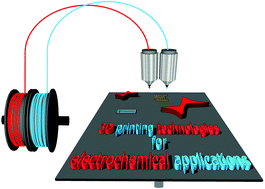3D-printing technologies for electrochemical applications†
Abstract
Since its conception during the 80s, 3D-printing, also known as additive manufacturing, has been receiving unprecedented levels of attention and interest from industry and research laboratories. This is in addition to end users, who have benefited from the pervasiveness of desktop-size and relatively cheap printing machines available. 3D-printing enables almost infinite possibilities for rapid prototyping. Therefore, it has been considered for applications in numerous research fields, ranging from mechanical engineering, medicine, and materials science to chemistry. Electrochemistry is another branch of science that can certainly benefit from 3D-printing technologies, paving the way for the design and fabrication of cheaper, higher performing, and ubiquitously available electrochemical devices. Here, we aim to provide a general overview of the most commonly available 3D-printing methods along with a review of recent electrochemistry related studies adopting 3D-printing as a possible rapid prototyping fabrication tool.


 Please wait while we load your content...
Please wait while we load your content...